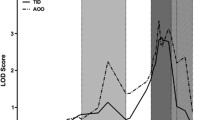Abstract
A full-length cDNA clone, pmSAP3, encoding the serum P component (SAP), has been used to search for DNA fragment length variation among mouse strains previously analyzed for differences in endogenous SAP levels. Three alleles were found usingEcoRI-digested DNA. The finding of a single 5.4-kb fragment, alleled, in DNA from DBA/2J mice suggests the presence of a singleSap locus. Segregation of DNA fragment associated withSap b andSap d alleles was analyzed in three sets of recombinant inbred (RI) strains. The strain distribution pattern found for theSap alleles was identical to that of alleles ofLy-9 in 43 individual RI strains, suggesting tight linkage withLy-9 on mouse chromosome 1. In the BXD RI strains, the SDP of theSap locus, defined by the difference in the endogenous SAP level, is also identical to the SDP of the DNA fragments. We propose to redesignate theSap locus to include both the structural element defined by the DNA polymorphism and the regulatory element involved in the regulation of SAP synthesis. TheSap locus is the major genetic element contributing to the regulation of SAP production. Other genetic factors are also involved, as shown by the presence of nonparental phenotypes in the individual BXH RI strains.
Similar content being viewed by others
References
Benson, M. D., Skinner, M., Shirahama, T., and Cohen, A. S. (1976). P component of amyloid: isolation from human serum by affinity chromatography.Arth. Rheum. 19749.
Elliott, R. W., and Berger, F. G. (1983). DNA sequence polymorphism in an androgen regulated gene is associated with alternation in the encoded RNAs.Proc Natl. Acad. Sci. USA 80501.
Feinberg, A. P., and Vogelstein, B. (1983). A technique for radiolabelling DNA restriction endonuclease fragments to high specific activity.Anal. Biochem. 1326.
Ishikawa, N., Shigemoto, K., and Maruyama, N. (1987). The complete nucleotide and deduced amino acid sequence of mouse serum amyloid P component.Nucl Acid. Res. 157186.
Ledbetter, J. A., Goding, L. W., Tsu, T. T., and Herzenberg, L. A. (1979). New mouse lymphoid alloantigen (Lgp100) recognized a monoclonal rat antibody.Immunogenetics 8347.
Levo, Y., Fragione, B., and Franklin, E. C. (1977). Amino acid sequence similarities between amyloid P component, Clt, and CRP.Nature 26856.
Mann, M. A., Silver, L. M., and Elliott, R. W. (1986). Genetic analysis of a mouset complex locus that is homologous to a kidney cDNA clone.Genetics 11499.
Maruyama, N., and Lindstrom, C. O. (1983).H-2-linked regulation of serum gp70 production in mice.Immunogenetics 17507.
Mortensen, R. F., Beisel, K., Zelenik, N. J., and Le, P. T. (1983). Acute phase reactants of mice. II. Strain dependence of serum amyloid P component (SAP) levels and response to inflammation.J. Immunol. 130885.
Mortensen, R. F., Le, P. T., and Taylor, B. A. (1985). Mouse amyloid P-component (SAP) levels controlled by a locus on chromosome 1.Immunogenetics 22367.
Pepys, M. B., Dash, A. C., Fletcher, T. C., Richardson, N., Munn, E. A., and Feinstein, A. (1978). Analogues in other mammals and in fish of human plasma proteins: C reactive protein and amyloid P componenet.Nature 273168.
Rordorf, C., Schnebli, H. P., Baltz, M. L., Tennent, G. A., and Pepys, M. B. (1985). The acute-phase response in (NZB × NZW) F1 and MRL/1 mice. Contrasting patterns resembling those in human systemic lupus erythematosus and rheumatoid arthritis, respectively.J. Exp. Med. 1561268.
Seldin, M. F., Morse, H. C., LeBoeuf, R. C., and Steinberg, A. D. (1988). Establishment of a molecular genetic map of distal mouse chromosome 1: Further definition of a conserved linkage group syntenic with human chromosome 1q.Genetics 248.
Silver, J. (1985). Confidence limits for estimates of gene linkage based on analysis of recombinant inbred strains.J. Hered. 76436.
Silver, J., and Buckler, C. E. (1986). Statistical considerations for linkage analysis using recombinant inbred strains and backcrosses.Proc. Natl. Acad. Sci. USA 831423.
Taylor, B. A. (1978). Recombinant inbred strains of mice: Use in gene mapping.In Morse, H. (ed.)Origins of Inbred Mice Academic Press, New York, p. 423.
Author information
Authors and Affiliations
Additional information
This study was performed through special Coordination Funds of the Science and Technology Agency of the Japanese Government and PHS Grant GM24464 to R.W.E.
Rights and permissions
About this article
Cite this article
Maruyama, N., Shigemoto, K., Kubo, S. et al. Chromosomal location of the gene encoding the murine acute-phase protein serum amyloid P-component (SAP). Biochem Genet 27, 229–237 (1989). https://doi.org/10.1007/PL00020157
Received:
Issue Date:
DOI: https://doi.org/10.1007/PL00020157




